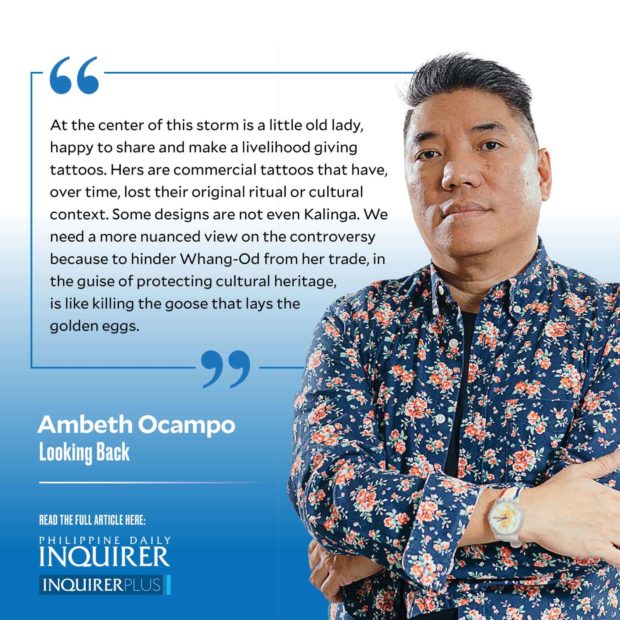Who owns Whang-Od and her tattoos?
In the 1990s, an investigation into the export of mummies and coffins stolen from Cordillera burial caves was sparked by a creepy Japanese collector who repurposed a mummy into a lampshade. As a result of the controversy, the National Museum, following new international conventions on ethical collecting, decided to return the mummies in their bodega to the highland caves where they belonged, beginning with the mummy of Apo Annu, returned to Benguet in 1999, decades after it was taken from a burial cave only to be donated to the museum much later by a freaked-out antique collector.
On field trips to the National Museum in the 1980s, my students huddled around a glass case with a mummy, drawn by dread and fascination. Its skin was best described as a cross between crunchy balat ng lechon and discolored parchment. Intricate tattoos painted all over its arms, chest, and back suggested two-fold bravery: endurance to pain during the tattoo process, that was a reward for the taking of a life or head during battle or raiding. Tattoos were worn with pride, like medals to modern-day soldiers. I asked, is it right to display a mummy, a corpse, in the National Museum? When my students replied that it was a way to learn about the past and indigenous traditions, I followed up with: would you feel the same way if that mummy in the glass case, gawked at by hordes of schoolchildren, is your grandfather?
Article continues after this advertisement“Pintados” to early Spanish chroniclers were people who were painted with tattoos. One of the illuminated images in the Boxer Codex, a late 16th-century manuscript, depicts a pair of men whose tattoos, from afar, resembled clothing. No genitals are exposed by the modest illustrator who left us with their backs, each butt cheek adorned with a sunburst. An imaginative academic declared these as the precolonial roots for the sun in our national flag!
With no mummies left for show and tell in the National Museum anymore I now comment on the tattoos of my students. Reminding them that the tattoos they sport, whether pierced and permanent or mere henna, are more than decoration. These were not easily obtained and were originally given as part of a ritual to be markers of prestige, culture, and social class. Friends who have trekked to Buscalan, Tinglayan, Kalinga, tell me that the once sleepy town (in)famous for marijuana farms has been overtaken by tattoo fever. This grew around Whang-Od, an ancient Kalinga woman (allegedly 104 years old) known for batok, a traditional method utilizing thorn and charcoal to draw tattoos. In time, Whang-Od became more than an international celebrity; she became a product whose name and face appear on souvenir photos, t-shirts, and coffee mugs. Her personal work, prized over all the other tattoo artists in the community, has been commodified, and tattoos deemed authentic by her three-dot signature are in great demand. I once considered getting these precious three dots but a tattoo will deny me entry into a Japanese onsen, the hot-spring baths I prefer over a painful experience of Kalinga culture.
Whang-Od has attracted controversy twice. First, when she was flown to Manila to ink-paying customers like any commercial tattoo artist. Second, when her master class on traditional tattooing was offered online for P750. Her grandniece cried exploitation on Facebook claiming Whang-Od did not sign a contract. She also cried cultural appropriation that was disrespectful both to her grandaunt and the Butbut tribe. Others chimed in. Did Whang-Od understand the contract translated to her orally before she affixed her signature? Did the foreign vlogger obtain “free and prior informed consent” not just from Whang-Od but from the entire community that co-owns the tattoo method and designs? Did a representative from the National Commission on Indigenous Peoples witness or attest to the contract?
Article continues after this advertisementAt the center of this storm is a little old lady, happy to share and make a livelihood giving tattoos. Hers are commercial tattoos that have, over time, lost their original ritual or cultural context. Some designs are not even Kalinga. We need a more nuanced view on the controversy because to hinder Whang-Od from her trade, in the guise of protecting cultural heritage, is like killing the goose that lays the golden eggs.
(More on Friday)

















